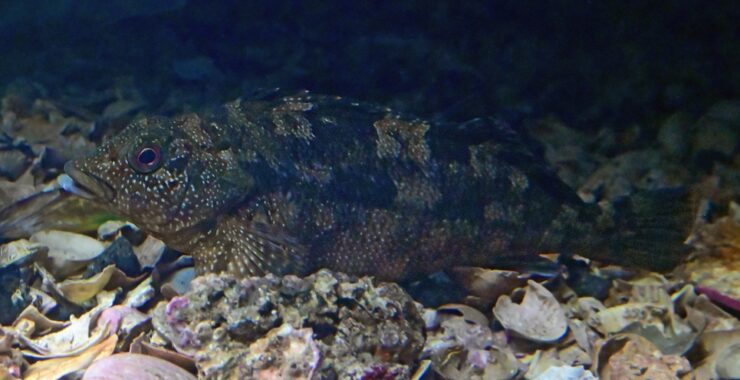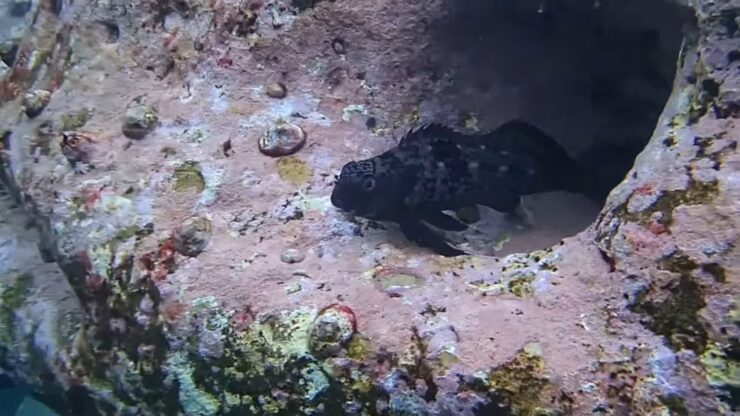Rock Cale is known as either “Crinodus lophodon” or “Aplodactylus lophodon” depending on who you want to listen to. It is found from northern New South Wales to northern Victoria. Mostly in shallow waters, while eating algae.
Physical Characteristics
The rocky waters are home to an unusual resident called the Rock Cale. With its sizable frame colored in hues from dark stormy to midnight navy, the Rock Cale’s bulky body allows it to withstand the churning tides. Its pale markings resemble the flecks of light that dance upon waves, offering protection within the shadows of the reef. But perhaps the most distinguishing feature is a saddle of even deeper black just below its dorsal fin – always the first thing spotted by keen eyes.
Carrying itself with a hunched yet hardy posture, the Rock Cale must battle the pull of the currents with its blunt snout scanning endlessly for sustenance. When hunting becomes tough, its broad pectoral fins – layered for strength against the constant clash of water – power it to new grazing grounds.
Read Also: Fish Facts: Wild Goldfish
Habitat
The rugged coastline is where the Rock Cale calls home. Among the tumultuous shallows just beneath churning waves, these fish flourish near the reefs’ stony peaks. Kelp forests and seaweed meadows cloak the seabed, granting both sustenance and safe havens from harm.
Here the Rock Cale can be seen at work or at rest, from the sun-flecked surface down to depths around thirty feet. Choosing waters alive with motion, they rely on the vibrant communities the rocky shores nurture. Anglers knows just where to spot inquisitive eyes and dappled scales peeking from tucked alcoves within surging tidepools and caverns.
Behavior
Though lacking teeth, the Rock Cale browses efficiently on the ample seaweed and algae growing in its reef and tidal areas. Its large chest fins aid maneuvering through surge zones to find nourishment. When waves strike forcefully, these fins also help the fish maintain stability against currents.
Over time, the Rock Cale has developed traits harmonizing it with the natural rhythms of its surroundings. Both physically and in daily activities, it has come to thrive right where turbulent waters meet the stony coast.
Read More: Fish Facts: Striped Blenny
Distribution
The distribution of the Rock Cale reflects its environmental preferences. This species is predominantly found in the southwestern Pacific Ocean, with a significant presence along the coast of New South Wales, Australia. It shows a clear affection for shallow, rocky shores and zones with high wave energy.
Through its ability to adapt to these conditions, the Rock Cale has become one of the most abundant large fish in its favored habitats. Its widespread numbers in these areas make it a crucial contributor to the diversity and equilibrium of the local marine life.
Importance in the Ecosystem
Rather than hunt larger prey, the Rock Cale prefers a diet of algae. It spends its days trimming away the seaweed so coral and plant life can flourish as they should. Without the Rock Cale’s grazing, algae could overtake the ecosystem like an unruly garden gone wild. When any part of the underwater landscape grows too much, the whole environment feels the effects.
But the Rock Cale doesn’t just clean up after itself – it also feeds the bigger members of the undersea community. Sharks and seals alike rely on the nutrient-rich fish for sustenance. In this way, the Rock Cale contributes to the complex web that links all ocean creatures together.
Conservation Status

Currently, there are no significant conservation concerns regarding the Rock Cale. Its abundance in its preferred habitats suggests that it is not under immediate threat. However, like all marine species, the Rock Cale could be affected by broader environmental changes, such as pollution and climate change.
Human Interaction
Human interaction with the Rock Cale is relatively limited compared to other marine species. It is not a primary target for commercial fishing, which reduces the pressure on its populations. However, recreational fishing and coastal development can impact its habitat.
Last Words
The Rock Cale is a fascinating marine species with unique physical characteristics and behaviors. Its preference for shallow, rocky shores and high-energy zones highlights its adaptability and resilience. As an important part of the marine ecosystem, the Rock Cale contributes to the balance of plant life and serves as a food source for larger predators.

